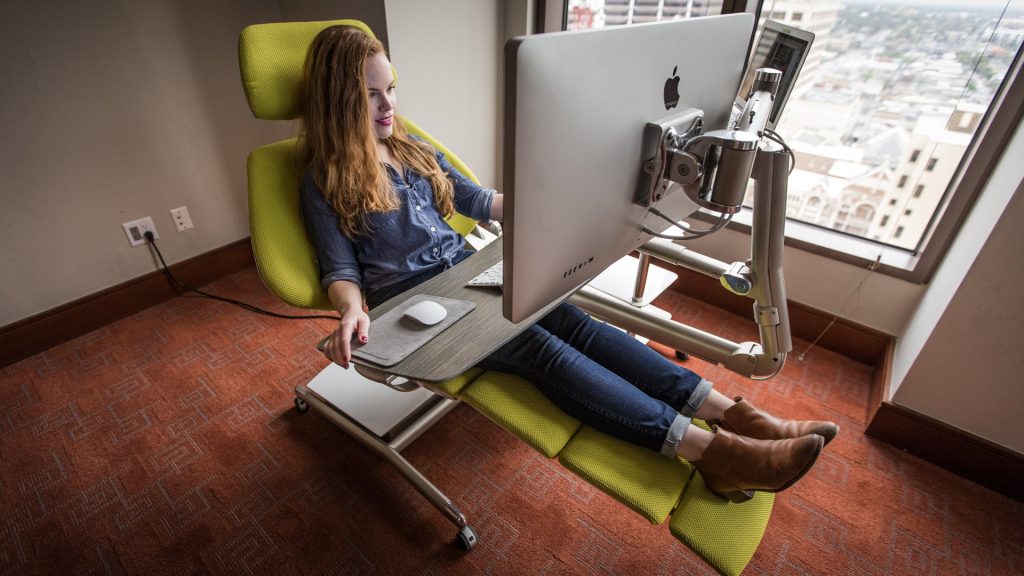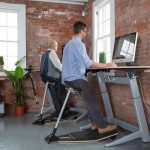Your sitting position has a more significant impact on how you feel than you might think. Poor sitting posture can put your spine out of alignment and cause muscle and bone problems, leading to neck and back pain.1
Whether working at a desk, studying, or relaxing, proper posture when seated can make a difference in your daily comfort and overall health.
This article explores the most supportive sitting positions for improving posture and reducing back pain.
Sitting Positions to Offset Pain
About 1 in 4 U.S. adults spend eight or more hours a day sitting, and up to 85% experience back or neck pain at some point in their lifetime.23
Sitting for long periods—especially if you’re slouching or hunched over a book or computer—can strain your back and neck muscles, bones, and joints. Minor adjustments to your sitting position can help relieve pain and discomfort and prevent long-term musculoskeletal issues and chronic pain.

Reclined Sitting Position
The reclined sitting position keeps your neck and torso straight and reclined between 105 and 120 degrees from the thighs; this position takes the pressure off your spine and can be helpful for people who struggle with lower back pain. To sit in a reclined position:4
- Use a reclining ergonomic or adjustable chair with a slightly tilted backrest.
- Keep your knees bent and feet flat on the floor or on a footrest.
- Maintain a neutral spine and avoid excessive slouching.
- Use a cushion or headrest to support your head and neck.
- Use a lumbar roll or pillow behind your lower back for extra support.
Declined Sitting Position
A declined sitting posture involves sitting on a chair that slopes downward. This position can be helpful when you’re experiencing hip or lower back pain. In this position, your buttocks are higher than your knees. To sit in a declined position:4
- Use a chair or cushion that inclines downward, with the higher end at your knees and the lower end at your hips.
- Ensure your lower back is well-supported to maintain the natural curve of your lumbar (lower) spine.
- Keep your feet flat on the floor or a footrest, with your knees bent at an angle of 90 degrees or higher.
- Maintain an upright torso with your shoulders relaxed and rolled back.
Worst Sitting Positions
While finding good sitting positions is essential for maintaining posture and reducing pain, it’s equally important to be aware of the worst sitting positions, which can strain muscles, ligaments, and the spine and contribute to pain and musculoskeletal problems. Unhealthy positions include:
- Slouching: Rounding your upper back, thrusting your neck forward, and hunching your shoulders creates excessive strain on your spine and can lead to tight muscles, pain, headaches, and eye strain.5
- Leg crossing: Crossing your legs for short breaks might be okay, but sitting this way for long periods can lead to a bent, asymmetrical posture.6
- Asymmetrical sitting:Sitting to one side, whether slumping or resting your chin on one hand, can lead to imbalances in your spine and muscles, increasing the risk of back, neck, and pelvic pain.7
Video: “Exercises for the Rehabilitation of Posture Disorders”
SET OF EXERCISES №1 TO IMPROVE POSTURE. ROUND BACK (SLOUCHING)
For additional information about exercises for the rehabilitation of Posture disorders you can watch a video demonstrating exercises and rehabilitation recommendations.
Sitting Positions to Improve Posture
Certain sitting positions can help strengthen your core muscles and promote spinal alignment to improve your posture.
Neutral Sitting Position
A neutral sitting position keeps your spine and limbs properly aligned and puts the least stress on your back, neck, and shoulders because it distributes your body weight evenly across all muscle groups. To sit in a neutral position:8
- Sit upright with your shoulders relaxed and rolled back.
- Keep your feet flat on the floor or a footrest, with your knees bent at a 90-degree angle.
- Support the natural curve of your lower back by using a rolled-up towel, lumbar roll, or back pillow. if your chair does not offer lumbar support.
- Keep your elbows close to your body, bent at 90- or 120-degree angles.
- Avoid crossing your legs.
If you work at a desk and use a computer, the top of the monitor should be at or below eye level. Elevate the monitor with a book or box to maintain proper posture and prevent hunching or slouching to see your screen.9
Active Sitting Position
Active or dynamic sitting engages your core muscles and encourages frequent slight movements to adjust your body and maintain balance, helping improve core strength and posture. Here’s how to do active sitting on a stability ball:10
- Ensure the ball or chair is the correct size for your height. Sit near the center of the stability ball, with your knees at a 90-degree angle.
- Ensure your feet are flat on the floor and hip-width apart for stability.
- Maintain an upright posture with your spine in a neutral position.
- Make adjustments by frequently shifting your body weight to keep your core muscles engaged and avoid slumping or leaning over to one side.
If a stability ball is not feasible, consider using an active sitting chair, such as a wobble stool or balance chair.
SET OF EXERCISES №2 TO STRENGTHEN THE MUSCLES OF THE BACK, NECK, STABILIZE THE SHOULDER BLADES OF THE UPPER SPINE
Ergonomic Adjustments
Maintaining proper posture for extended periods often requires ergonomic adjustments to your workspace if you work at a desk. To adjust your workspace for optimal posture support, do the following:11
- Adjustable chair: Use an adjustable chair with lumbar (lower back) support. Adjust the chair height so your feet are flat on the floor or a footrest. The armrests should be at elbow height.
- Desk height:When resting on the desk or arms of your chair, your elbows should form a 90-degree angle, with your shoulders relaxed. If your desk is too high or low, consider an adjustable sit-stand desk or a computer monitor stand to achieve this position.
- Monitor position: The monitor should be an arm’s length away, centered on your body, with the top at eye level (2–3 inches below the top of the monitor).
- Keyboard and mouse: The keyboard should be flat and placed directly in front of the monitor, with the letters G and H on the keyboard aligned with your nose. Place the mouse adjacent to the keyboard.
Be mindful of your posture and make adjustments as needed throughout the day. Remember to take frequent breaks throughout the day to stand up, move around, and stretch your muscles to prevent stiffness and discomfort.
Conditions That Can Make Sitting Uncomfortable
Certain conditions can make prolonged sitting uncomfortable regardless of position, including:121314
- Chronic lower back pain
- Pelvic floor dysfunction (having either too much or too little tension in the pelvic floor muscles, which stabilize your core when seated)
- Recent vaginal or cesarean section (C-section) delivery
- Piriformis syndrome (a condition that causes buttocks muscle spasms)
- Sciatica (a chronic pain condition affecting the legs, hips, back, and feet)
SET OF EXERCISES №3 TO IMPROVE POSTURE. FLAT BACK
Floor Sitting Positions and Poses
Floor sitting offers an alternative to chairs and can promote improved posture and flexibility with the right positions. Some floor positions require good hip and ankle flexibility; sitting only in comfortable positions is essential to prevent injury.
Seiza Position
The seiza position is a traditional floor-sitting position in Japan. It promotes good spinal alignment and core muscle engagement to improve posture. Here’s how to sit seiza style:15
- Kneel on the floor with your knees together and your feet tucked under your body.
- Gently sit back so that your buttocks rest on your heels, with your toes pointing straight back.
- Keep your back straight and shoulders relaxed.
- Place your hands on your thighs or in your lap.
Cross-Legged Position
Sitting cross-legged, or crisscross, is a common and comfortable floor position. Cross-legged floor sitting can help open your hips, strengthen back muscles, and improve posture.16 Some evidence suggests it supports digestion and leads to better breathing. Here’s how to do it with proper posture in mind:17
- Sit on the floor with the soles of your feet facing each other and resting on opposite thighs.
- Engage your core muscles, keep your back straight, and avoid hunching forward.
- Pull your shoulders back and relax them away from your ears.
If this position strains your buttocks, ankles, or knees, you can make the pose more comfortable using a cushion or yoga blocks.
Straddle Sit Position
The straddle sit effectively stretches the inner thighs and hamstrings and aligns the spine. Here’s how to do it:18
- Sit on the floor with your legs extended in front of you.
- Slowly spread your legs wide apart, forming a V-shape.
- Maintain an upright posture, with your spine elongated.
- Rest your hands on your legs or the floor in front of you.
SET OF EXERCISES №4 TO IMPROVE POSTURE. SPINE CURVATURE (SCOLIOSIS)
How to Find a Good Sitting Position on Long Drives
Sitting during long road trips can lead to back pain and fatigue. Finding the right sitting position—and taking some stretch breaks—can make long drives more comfortable.19

Adjust Your Seat
The first step to finding a good sitting position is adjusting your seat so that you can sit comfortably and drive safely.19 Do so as follows:
- Seat height:Ensure your seat is at a height where your hips are slightly higher than your knees, and your feet can comfortably reach the pedals.
- Seat tilt: Adjust the seat tilt so that your thighs are fully supported with a two-finger gap between your knees and the edge of the seat to avoid pressure on your knees.
- Backrest angle: Recline the backrest slightly (around 100–110 degrees) to support your spine and reduce pressure on your lower back.
Lumbar Support
Proper lumbar (lower back) support prevents muscular fatigue and discomfort on long drives.19 Get it as follows:
- Built-in support:Some vehicles have built-in lumbar support, which you can adjust to fit the natural curve of your lower back.
- Portable cushion:If your car seats lack lumbar support, use a portable lumbar cushion or a rolled-up towel to provide the necessary support.
Steering Wheel Position
Adjusting the steering wheel in the following ways can help maintain a comfortable and ergonomic sitting position:19
- Height:Adjust the steering wheel height so that your shoulders remain relaxed and your wrists rest on the top of the wheel when you extend your arms.
- Distance:Ensure the steering wheel is at a comfortable distance so that your elbows are slightly bent (around 60 degrees) when holding the wheel.
Headrest Position
Proper headrest positioning, as follows, is essential for neck and upper back comfort:19
- Height:Adjust the headrest so that the top is at least as high as the top of your head.
- Distance:Position the headrest close to the back of your head (no more than 2 inches away) to support your neck during sudden stops.
Regular Breaks and Stretches
Regular stretch breaks can help prevent stiffness and pain on long road trips.19 Tips include:
- Break frequency:Aim to take a break every one to two hours to stand up, stretch, and walk around.
- Stretching:Perform neck rolls, shoulder shrugs, and leg stretches to relax your muscles and reduce tension.
Summary
Your sitting position significantly impacts how you feel, especially if you sit for prolonged periods. Bad sitting posture can trigger or worsen back pain and increase the risk of chronic pain and musculoskeletal problems.
Whether you’re working or studying at a desk, taking a long drive, or sitting on the floor, there are positions to promote proper spinal alignment and posture. Find what works, and stretch throughout the day. If you have a condition that makes sitting challenging or painful, ask a healthcare provider for guidance to avoid pain and improve your posture.

CHECK OUT THE DEMO VERSION OF OUR SETS OF EXERCISES FOR THE REHABILITATION OF POSTURE DISORDERS ON YOUTUBE
Our website presents the following sets of exercises for the rehabilitation of Posture disorders:
-
SET OF EXERCISES №1 TO IMPROVE POSTURE. ROUND BACK (SLOUCHING)
-
SET OF EXERCISES №2 TO STRENGTHEN THE MUSCLES OF THE BACK, NECK, STABILIZE THE SHOULDER BLADES OF THE UPPER SPINE
-
SET OF EXERCISES №3 TO IMPROVE POSTURE. FLAT BACK
-
SET OF EXERCISES №4 TO IMPROVE POSTURE. SPINE CURVATURE (SCOLIOSIS)




